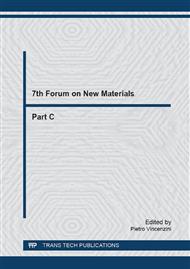[1]
Green, M.A., Photovoltaic principles. Physica E: Low-dimensional Systems and Nanostructures, 2002. 14(1): pp.11-17.
Google Scholar
[2]
Yang, B., et al., Enhanced photoelectrochemical activity of sol-gel tungsten trioxide films through textural control. Chemistry of Materials, 2007. 19(23): pp.5664-5672.
DOI: 10.1021/cm071603d
Google Scholar
[3]
Huang, Q., Z. Ye, and X. Xiao, Recent progress in photocathodes for hydrogen evolution. Journal of Materials Chemistry A, 2015. 3(31): pp.15824-15837.
DOI: 10.1039/c5ta03594e
Google Scholar
[4]
Paracchino, A., et al., Highly active oxide photocathode for photoelectrochemical water reduction. Nature materials, 2011. 10(6): pp.456-461.
DOI: 10.1038/nmat3017
Google Scholar
[5]
Jiang, H. -q., et al., Fabrication and efficient photocatalytic degradation of methylene blue over CuO/BiVO4 composite under visible-light irradiation. Materials Research Bulletin, 2009. 44(3): pp.700-706.
DOI: 10.1016/j.materresbull.2008.06.007
Google Scholar
[6]
Kudo, A., et al., Photocatalytic O2 evolution under visible light irradiation on BiVO4 in aqueous AgNO3 solution. Catalysis Letters, 1998. 53(3-4): pp.229-230.
Google Scholar
[7]
Seabold, J.A. and K. -S. Choi, Efficient and stable photo-oxidation of water by a bismuth vanadate photoanode coupled with an iron oxyhydroxide oxygen evolution catalyst. Journal of the American Chemical Society, 2012. 134(4): pp.2186-2192.
DOI: 10.1021/ja209001d
Google Scholar
[8]
Li, J. and N. Wu, Semiconductor-based photocatalysts and photoelectrochemical cells for solar fuel generation: a review. Catalysis Science & Technology, 2015. 5(3): pp.1360-1384.
DOI: 10.1039/c4cy00974f
Google Scholar
[9]
Park, Y., K.J. McDonald, and K. -S. Choi, Progress in bismuth vanadate photoanodes for use in solar water oxidation. Chemical Society Reviews, 2013. 42(6): pp.2321-2337.
DOI: 10.1039/c2cs35260e
Google Scholar
[10]
Jia, Q., K. Iwashina, and A. Kudo, Facile fabrication of an efficient BiVO4 thin film electrode for water splitting under visible light irradiation. Proceedings of the National Academy of Sciences, 2012. 109(29): pp.11564-11569.
DOI: 10.1073/pnas.1204623109
Google Scholar
[11]
Huang, Z. -F., et al., Nanostructured bismuth vanadate-based materials for solar-energy-driven water oxidation: a review on recent progress. Nanoscale, (2014).
DOI: 10.1039/c4nr05245e
Google Scholar
[12]
Eisenberg, D., H.S. Ahn, and A.J. Bard, Enhanced photoelectrochemical water oxidation on bismuth vanadate by electrodeposition of amorphous titanium dioxide. Journal of the American Chemical Society, 2014. 136(40): pp.14011-14014.
DOI: 10.1021/ja5082475
Google Scholar
[13]
Su, J., et al., Nanostructured WO3/BiVO4 heterojunction films for efficient photoelectrochemical water splitting. Nano letters, 2011. 11(5): p.1928-(1933).
DOI: 10.1021/nl2000743
Google Scholar
[14]
Balachandran, S., et al., Facile construction of heterostructured BiVO4–ZnO and its dual application of greater solar photocatalytic activity and self-cleaning property. Industrial & Engineering Chemistry Research, 2014. 53(20): pp.8346-8356.
DOI: 10.1021/ie404287m
Google Scholar
[15]
Bornoz, P., et al., A bismuth vanadate–cuprous oxide tandem cell for overall solar water splitting. The Journal of Physical Chemistry C, 2014. 118(30): pp.16959-16966.
DOI: 10.1021/jp500441h
Google Scholar
[16]
Venkatesan, R., S. Velumani, and A. Kassiba, Mechanochemical synthesis of nanostructured BiVO 4 and investigations of related features. Materials Chemistry and Physics, 2012. 135(2): pp.842-848.
DOI: 10.1016/j.matchemphys.2012.05.068
Google Scholar
[17]
Yu, J. and A. Kudo, Effects of structural variation on the photocatalytic performance of hydrothermally synthesized BiVO4. Advanced Functional Materials, 2006. 16(16): pp.2163-2169.
DOI: 10.1002/adfm.200500799
Google Scholar
[18]
Yoon, H., et al., Nanotextured Pillars of Electrosprayed Bismuth Vanadate for Efficient Photoelectrochemical Water Splitting. Langmuir, 2015. 31(12): pp.3727-3737.
DOI: 10.1021/acs.langmuir.5b00486
Google Scholar


